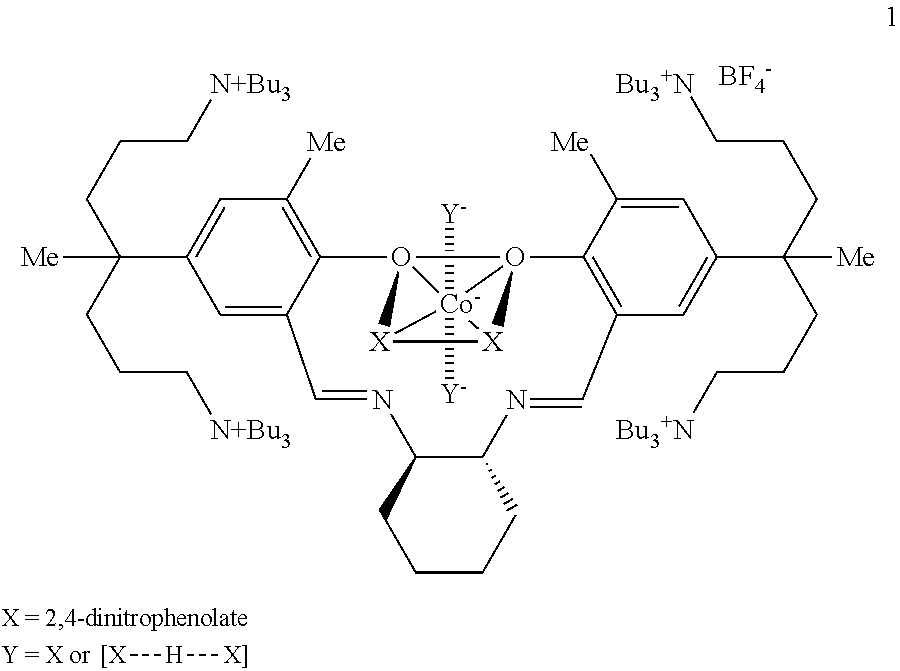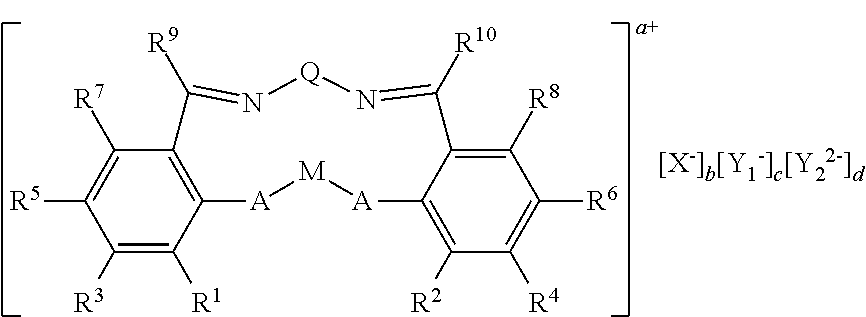Novel Complex and Preparation Method of Poly(Alkylene Carbonate) Using the Same
a technology of alkylene carbonate and complex, which is applied in the field of new complex and preparation method of poly (alkylene carbonate) using the same, can solve the problems of predetermined limitations imposed on the applications that may be developed, insufficient mechanical strength, and deterioration of catalyst system activity, so as to promote polymerization and simple structure , the effect of excellent activity
- Summary
- Abstract
- Description
- Claims
- Application Information
AI Technical Summary
Benefits of technology
Problems solved by technology
Method used
Image
Examples
preparation example 1
[0107]A cobalt-Salen catalyst 6 was prepared by the following Reaction Formula 1:
[0108]Paraformaldehyde (0.7 g) and N-methylpiperazine (2.6 mL) were dissolved into acetonitrile (40 mL), and salicylaldehyde 2 (3.4 g) was added thereinto and stirred at 80° C. for 10 hours. When the reaction was completed, a saturated ammonium chloride aqueous solution was added thereinto to terminate the reaction, and the reactant was extracted with dichloromethane three times. An organic layer was separated and dried by magnesium sulfate, followed by filtration and distillation under reduced pressure to remove a solvent and obtain salicylaldehyde 3 containing piperazine (5.5 g). The prepared salicylaldehyde derivative 3 (3.6 g) was added into a round bottom flask wrapped with aluminum foil and was dissolved into acetonitrile (25 mL) and then 1-iododebutane (1.8 mL) was added thereinto, followed by stirring at 80° C. for 8 hours. A solvent was removed by distillation under reduced pressure, the reacta...
preparation example 2
[0110]A cobalt-Salen catalyst 9 was prepared by the following Reaction Formula 2:
[0111]The salicylaldehyde derivative 3 (0.5 g) prepared by the same method as Preparation Example 1 above was added into a round bottom flask wrapped with aluminum foil and was dissolved into acetonitrile (10 mL) and then 1-bromohexane (0.3 mL) was added thereinto, followed by stirring at 80° C. for 8 hours. A solvent was removed by distillation under reduced pressure, the reactant was dissolved into dichloromethane (10 mL) and silver nitrate (0.25 g) was added thereinto, followed by stirring at room temperature for 6 hours. After the reaction solution was filtered when the reaction was completed, a solvent was removed by distillation under reduced pressure to obtain a salicylaldehyde derivative 7 containing amine and an ammonium salt (0.5 g). The salicylaldehyde derivative 7 containing amine and an ammonium salt (0.5 g) and 1,2-trans-diaminocyclohexane (0.07 mL) were dissolved into dichloromethane (6 m...
preparation example 3
[0113]A cobalt-Salen catalyst 12 was prepared by the following Reaction Formula 3:
[0114]The salicylaldehyde derivative 3 (0.5 g) prepared by the same method as Preparation Example 1 above was added into a round bottom flask wrapped with aluminum foil and was dissolved into acetonitrile (10 mL) and then 1-iodooctane (0.3 mL) was added thereinto, followed by stirring at 80° C. for 10 hours. A solvent was removed by distillation under reduced pressure, the reactant was dissolved into dichloromethane (10 mL) and silver nitrate (0.3 g) was added thereinto, followed by stirring at room temperature for 6 hours. After the reaction solution was filtered when the reaction was completed, a solvent was removed by distillation under reduced pressure to obtain a salicylaldehyde derivative 10 containing amine and an ammonium salt (0.6 g). The salicylaldehyde derivative 10 containing amine and an ammonium salt (0.6 g) and 1,2-trans-diaminocyclohexane (0.07 mL) were dissolved into dichloromethane (6...
PUM
 Login to View More
Login to View More Abstract
Description
Claims
Application Information
 Login to View More
Login to View More - R&D Engineer
- R&D Manager
- IP Professional
- Industry Leading Data Capabilities
- Powerful AI technology
- Patent DNA Extraction
Browse by: Latest US Patents, China's latest patents, Technical Efficacy Thesaurus, Application Domain, Technology Topic, Popular Technical Reports.
© 2024 PatSnap. All rights reserved.Legal|Privacy policy|Modern Slavery Act Transparency Statement|Sitemap|About US| Contact US: help@patsnap.com










